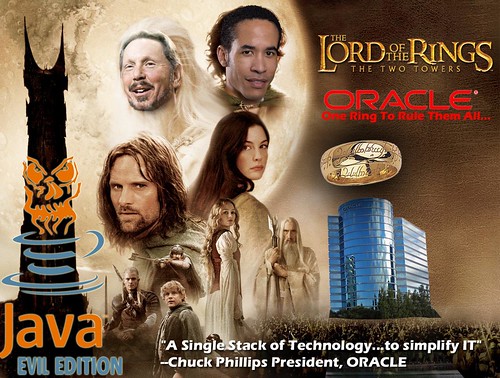Oracle's Fusion middleware master plan starts coming together

Oracle on Wednesday launched its Fusion 11g middleware family and the effort is aimed at linking the technological underpinnings of all of the company's acquired applications, owning the market, creating one fundamental software stack for the enterprise, laying the foundation for a cloud strategy as well as a few other things we're probably forgetting.
At this juncture, the big picture behind Fusion has yet to emerge---especially with the cloud computing angle, according to Dana Gardner. To say there are a few moving parts in Oracle's Fusion day is a bit of an understatement (Techmeme, Twitter). The company launched Oracle Fusion Middleware 11g, Oracle SOA Suite, WebLogic Suite, Web Center Suite and Identity Management.
Gardner has the recap and the statements abound (see all Oracle Fusion content, whitepapers and posts), but let's zoom out a bit. What does this Fusion fiesta really mean? That question has historically been difficult to answer. I've been trying to wrap my head around Fusion for at least four years now and it still doesn't click most of the time. In a nutshell, Fusion is the glue that ties everything together and perhaps provides a path to some uber suite. In the meantime, Oracle will support your existing software under current licensing arrangements and charge you maintenance forever.
Also see: Get ready for Oracle's 100 days of press releases aka innovation
Oracle Fusion Middleware 11g: turkeys voting for Christmas?
Gardner argues that the Fusion Middleware 11g will ultimately be about the cloud. Gardner writes:
The glaring missing link now, however, is the cloud element of Oracle’s destiny. With such a broad infrastructure, data lifecycle, and apps/services development portfolio — not to mention deep hooks into Oracle’s burgeoning business applications offerings — the only needed outcome to fulfill is the “any” in “anyware.” That must include a fluid sourcing, hosting and business model future — the nearly obvious Oracle Cloud.
Now that it’s here, the 11g continental conglomeration must be the gateway for the enveloping 12c, as in “c” for cloud. You don’t need to be an oracle to factor that clear and necessary path to the future.
That take sounds plausible---except there's no money in the cloud right now. Chances are Oracle is setting itself up for the day where SaaS, cloud and on-demand computing overtakes the traditional licensing, support and maintenance cycle. Perhaps it'll be 13c by time Oracle gets around to it.
Miko Matsumura, a SOA expert and chief strategist for Software AG, had more than a few quips about the Fusion launch. Over at SOA Center, Matsumura pans the idea that you need a single Oracle stack to simplify your infrastructure.
Matsumura writes:
Handing your Enterprise Architecture over to Oracle is unrealistic. For end-users who want to capitulate and give up on IT as a provider of competitive differentiation, this might seem like a way of reducing cost and complexity. In the short term, they will be able to reduce their costs by eliminating most of their IT departments. However, in the long term, being beholden to the Dark Lord Sauron, the master of the ring will prove to be expensive.
Granted Matsumura has a loaded opinion, but you have to give him props for the graphic he cooked up.

And then there's the Wall Street take. Wall Street just loves Oracle these days. And why not? The company has a maintenance revenue stream to die for. Caris analyst Curtis Shauger says:
Several years in the making, ORCL is finally set to release its Fusion 11G product on July 1st of this year. Not only does Fusion represent the technological underpinnings for integrating the many disparate application companies it has purchased over the years (i.e. Peoplesoft, Siebel, etc), but also represents a major strategic push for the Java ecosystem in its ongoing battles with Microsoft (.NET) and IBM (Websphere). As such, it would seem that its recent acquisition of BEA, the leading Java-based application server, and Sun Micro, the developer and primary backer of Java, represent significant components of ORCL’s overall strategy for Fusion. While there are a lot of moving parts to ORCL’s strategy, it would seem it is positioning Fusion and Java for a much broader play on cloud computing with an eye on taking market share from IBM, the leading middleware vendor.
Perhaps the biggest takeaway is that Oracle has a nice middleware product cycle coming down the pike and the acquisition of Java via the Sun deal will only strengthen that position. All you need to know is that Oracle will have more stuff to sell you pronto.
Also see: Can Oracle give Java a boost (and monetize it better)?